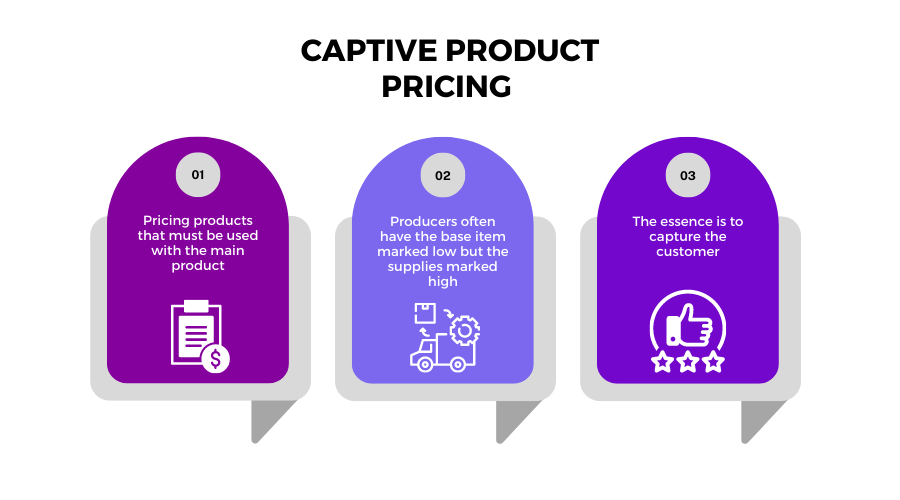
What is Captive Product Pricing?
Captive product pricing definition
“Captive product pricing is a marketing and profit incremental strategy. In this pricing strategy, you sell a core product at a low price, and the essential accessories are sold at a high price to support the profit margins.”
Captive product pricing comes under product line pricing.
It refers to a strategy that helps attract consumers to the main product set at a low price. Then, you strongly recommend them to buy the accessory that goes with the main product.
Without this accessory, the product may not be functional. Hence the customer must buy the full effect (main and captive).
A widespread household example of this strategy is the razor and razor blade.
Razor, the core product, is sold at a meager price, whereas the blade (and the cream), the captive product, is sold at a higher rate.
Other examples include gaming apps that are free to play but come with a wide range of in-app accessories that users can purchase.
The game gets the users hooked and tempts them to buy additional accessories for a better gaming experience.
Captive products are those accessories that make a product complete.
A computer will need a printer, joystick, and console as accessories. So for pricing, it has already lost to competitors that offer competitive pricing.

Why Do Companies Use Captive Pricing?
Simply put, captive product pricing helps companies generate more revenue and sales. But sometimes, the companies will have to deal with a few product sales losses.
Companies mainly put the enhancing supplementary products at a higher rate for sale. This way, it helps them compensate for the lower prices of the main product.
It would be best to balance the prices of both the core and captive products. If the cost of the captive product is too high, the sales for the main product might be significantly affected.
What Are the Captive Product Pricing Examples?
Let us look at the SaaS captive product pricing example.
Captive product pricing is not the same in SaaS for other physical products.
The simplest example is the freemium package.
Companies may offer free subscriptions for starters. The customers will have an option to get more features and avail of the upgraded version of software products. All of this is for additional pricing.
You can show your customers that the upgraded version has more features to help them.
This strategy of captive product pricing will also help them generate average revenue per unit (ARPU) after a while.
Difference Between Optional Product Pricing and Captive Product Pricing
You can sell the main product at a low rate in captive product pricing. On the other hand, you sell the supplementary product at high speed. Here the captive products “can be used” with the main product.
The optional product pricing is the same, except the supplementary product is “bought or sold” with the main product.
The companies in the optional product pricing make up for the loss of pricing in the main product with the supplementary products.
Let’s not confuse you more, but look at an example that will give a clearer picture.
With new airline companies entering the market, all the others needed to cut their flight prices.
The companies strategize and use optional product pricing, and they charge for the things that come with the ticket.
Services such as food, bag checking, and other services that the airlines can make up for the “lost money” will charge you extra.
Benefits of Captive Product Pricing Strategy
- Lower pricing of the core product invites the customer, whereas higher pricing of the captive (accessories) products balances the profit margins.
- As the customer base increases because of the low pricing of core products, the sales of captive products also rise.
- It helps in customer retention and revenue growth.
For customer retention, you will also need to obtain customer feedback to improve and satisfy your features.

Limitations of Captive Product Pricing
- Don’t over-exploit the captive product advantage by excessively high pricing. That may lead to customers’ disappointment.
- High captive pricing may harm the brand value and image.
- There could be a failure to provide the best quality accessories.
- The domain of accessories has to be vast and ever-evolving.
- Monotonous pairs of core and captive products may lead to a decline in sales, most probably in games with in-app purchases.
FAQs
You can use both the core and captive products as a pair. So when sales of core products increase due to low prices, the sales of captive products also increase.
The whole strategy is based on increasing sales and profitability. When you sell a core product at a low price, you can balance out its low profit through the profit margins of the accessories sold at a high price.
Some commonly known companies that use this strategy are Gillette, Apple, Nintendo, EA Sports, and so on.
